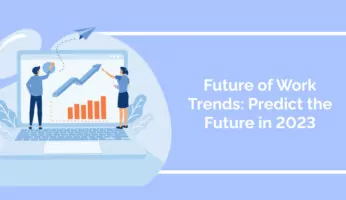
The remote work paradigm has dramatically affected every aspect of the workplace, from social dynamics to workforce management to onboarding and offboarding.
To deliver great employee experiences in this remote era, managers and HR professionals need to adapt.
Fortunately, adapting isn’t so difficult.
The employee experience doesn’t need to be redesigned from the ground up, it simply needs to be digitized.
Digitizing workflows and the workplace does require effort, however, so HR managers should approach this topic strategically.
How to Engage Remote Workers
Employee engagement has always been and will always be a top concern for HR professionals, managers, and business leaders. Engagement, after all, directly affects critical employee metrics such as employee productivity, employee retention, and employee sentiment, among others.
In 2020, however, COVID-19 radically shifted the way we work. Employees around the world were required to work from home (even giving rise to the acronym WFH). This shift had a major impact on social dynamics, workflows, the workplace culture, business processes, and more – all of which had a significant effect on worker engagement.
To keep up, both now and in the future, it is crucial to develop new workforce engagement strategies that are suited to both onsite and offsite working arrangements.
Following this basic process can help managers and HR professionals keep up with these disruptive changes:
Itemize the challenges and opportunities of remote work
Before designing a strategy to maximize remote employee engagement, it is necessary to understand the pros and cons of remote work.
According to research firms that have surveyed remote workers, such as Buffer, there are major benefits to remote working, such as:
- More flexible schedules
- Not needing to commute
- More time to spend with the family
- Fewer workplace distractions
- The ability to work from anywhere
Despite these advantages, there are also downsides to remote work, which can include:
- Difficulty collaborating with coworkers
- Social isolation
- The lack of a day-to-day office routine
- Distractions in the home environment
- Poor internet connection
- Inadequate office equipment
Since every workplace is different, it is important to create a strategy that is based on your employees’ unique needs and work styles.
Learn from employees, then design a plan to boost engagement
With the right tools, surveying employees is simple – and smaller companies can even use email to poll workers.
That poll can be used to:
- Understand pain points
- Learn what is working for them and what isn’t
- Get suggestions for improvement
All of this data, in turn, can be used to address the most common problems associated with remote work and develop potential solutions.
For instance:
- If social isolation is the most commonly reported issue, for instance, managers could add more online social time as a remedy
- If learning new workflows and tools is a challenge, managers can implement digital adoption platforms (DAPs) to automate employee training and boost skills
- If collaboration is an issue, project management apps can be used to improve communication
In short, the factors that influence employee engagement will vary dramatically from workplace to workplace. The methods for improving that engagement, therefore, should be just as unique.
Engagement, while important, only represents one of the top challenges faced by managers in the remote workplace – another is how to handle the beginning and end of an employee’s tenure.
How Has Remote Work Changed Onboarding and Offboarding?
Another major implication of the COVID-19 pandemic was a dramatic shift in workforce compositions.
Many companies lost workers as their businesses were forced to consolidate or, in some cases, fold. Other organizations were able to grow in 2020, through effective positioning, quick maneuvering, luck, or a combination of those factors.
Among other things, these shifts meant that HR managers quickly needed to learn how to both onboard and offboard employees remotely. Yet since these processes have typically been performed face-to-face, this also meant that HR managers needed to develop new strategies for completing this process entirely online.
Here is a basic process to follow when digitizing both onboarding and offboarding:
Use communication tools to maintain a human touch
Social isolation, as mentioned above, is one of the most common problems associated with remote work.
It can also be a problem when hiring and onboarding new employees. The remoteness from other workers, for instance, can make employees feel alienated and distant from the company they have just been recruited to. Those feelings of isolation, in turn, can negatively affect other aspects of their work, such as engagement, productivity, and collaboration.
To counteract this, managers and HR managers should regularly check in via video conferencing apps to assess progress, ask new hires if they have questions, and gauge sentiment.
Also, since day-to-day social interaction is lacking in a remote work environment, it is important to be far more proactive when it comes to addressing employee concerns, performance, and progress.
Simplify onboarding and offboarding with automations and templates
Certain software applications, such as HCM platforms, project management tools, and DAPs, can be used to simplify onboarding in a remote work environment. The time and effort saved can then give managers more opportunities to focus on employees – instead of spending their time focusing on the technical aspects of their jobs.
For instance:
- Use software analytics to track employee performance and discover learning blocks before they interfere with performance
- Implement self-service apps, such as DAPs, to provide just-in-time learning and training
- Use automation platforms to take care of tedious or repetitive tasks, such as sending out communications, paperwork, or meeting requests
While many feel that AI and automation tools will make the workplace less human, this example shows that they can also make the workplace more human. By freeing up manages’ time from technical tasks, automation gives them more time to interact with and focus on their teams.
WalkMe Team
WalkMe spearheaded the Digital Adoption Platform (DAP) for associations to use the maximum capacity of their advanced resources. Utilizing man-made consciousness, AI, and context-oriented direction, WalkMe adds a powerful UI layer to raise the computerized proficiency, everything being equal.



